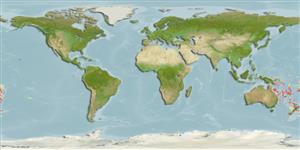Klassifizierung / Names
Namen | Synonyme | Catalog of Fishes(Gattung, Arten) | ITIS | CoL | WoRMS | Cloffa
>
Callionymiformes (Dragonets) >
Draconettidae (Slope dragonets)
Etymology: Centrodraco: Greek, kentron = sting + Greek, drako = dragon (Ref. 45335); atrifilum: Named for the black filament on the second spine of the first dorsal fin; Latin 'ater' for black and ‘filum’ for thread..
More on author: Fricke.
Environment: milieu / climate zone / depth range / distribution range
Ökologie
seewasser benthopelagisch; tiefenbereich 437 - 640 m (Ref. 84091). Deep-water
Western Pacific: Australia.
Size / Gewicht / Alter
Maturity: Lm ? range ? - ? cm
Max length : 2.1 cm SL Männchen/unbestimmt; (Ref. 84091); 3.4 cm SL (female)
Kurzbeschreibung
Morphologie | Morphometrie
This species is distinguished by having the following characters: anal fin rays 12-13; second dorsal fin rays, 13-14; first dorsal fin with second spine elongate and filamentous in both sexes, the second dorsal fin with no filaments in males; male body colour pattern dorsally with 3 pairs of vertical dark brown streaks, followed by a single saddle below the end of the second dorsal fin and on the caudal peduncle (Ref. 84091).
Specimen was collected with a beam trawl, probably on soft bottom for species of Centrodraco usually occur on patches of soft substrate on the continental slope. Extremely rare in collections, and probably also biologically rare (Ref. 84091).
Life cycle and mating behavior
Geschlechtsreife | Fortpflanzung | Ablaichen | Eier | Fecundity | Larven
Fricke, R., 2010. Centrodraco atrifilum, a new deepwater dragonet species from eastern Australia (Teleostei: Draconettidae). Stuttgarter Beiträge zur Naturkunde A, Neue Serie 3:341-346. (Ref. 84091)
IUCN Rote Liste Status (Ref. 130435)
Bedrohung für Menschen
Harmless
Nutzung durch Menschen
Mehr Information
NamenSynonymeMetabolismusRäuberÖkotoxikologieFortpflanzungGeschlechtsreifeAblaichenSpawning aggregationFecundityEierEientwicklung
Alter/GrößeWachstumLänge-GewichtLänge-LängeLängenhäufigkeitenMorphometrieMorphologieLarvenLarven Pop.Dyn.RekrutierungDichteBRUVS
ReferenzenAquakulturAquakultur ProfilZuchtlinienGenetikElectrophoresesVererbbarkeitKrankheitenVerarbeitungNutrientsMass conversion
PartnerBilderStamps, Coins Misc.LauteCiguateraGeschwindigkeitSchwimmstilKiemenoberflächeOtolithsGehirngrößeSehfähigkeit
Tools
Zusatzinformationen
Download XML
Internet Quellen
Estimates based on models
Preferred temperature (Ref.
123201): 6.7 - 10.2, mean 7.7 °C (based on 62 cells).
Phylogenetic diversity index (Ref.
82804): PD
50 = 0.5001 [Uniqueness, from 0.5 = low to 2.0 = high].
Bayesian length-weight: a=0.00389 (0.00180 - 0.00842), b=3.12 (2.94 - 3.30), in cm total length, based on all LWR estimates for this body shape (Ref.
93245).
Trophic level (Ref.
69278): 3.1 ±0.4 se; based on size and trophs of closest relatives
Fishing Vulnerability (Ref.
59153): Low vulnerability (10 of 100).
